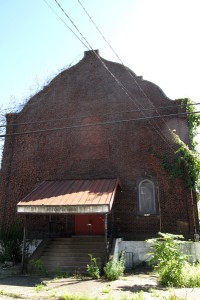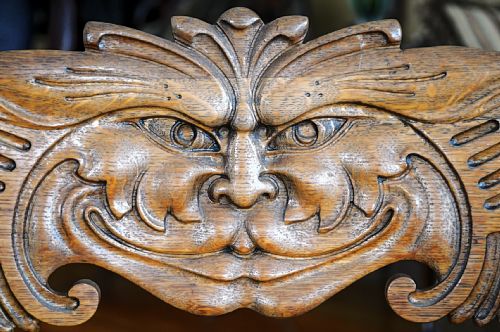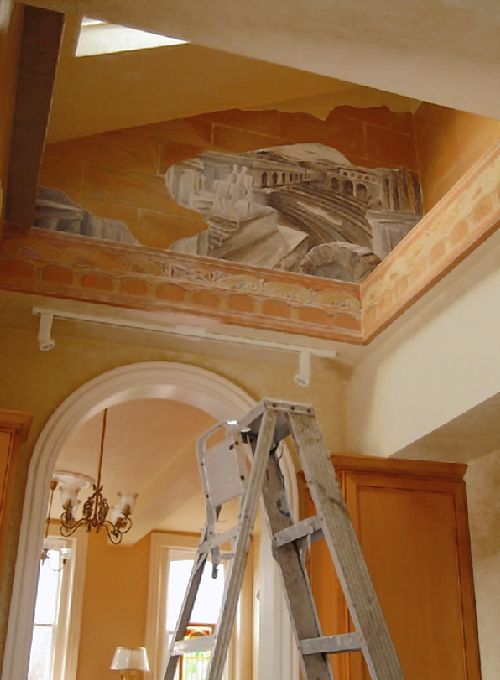
Category Archive: Preservation News
-
Historic Crafton Elementary School Threatened with Closure
PHLF News
January 28, 2011In 2010, the Carlynton School District conducted a district-wide facilities-use study on renovating or replacing its two elementary schools: the Carnegie Elementary School and the Crafton Elementary School.
The Crafton Elementary School, built in 1913 and designed by architect Press C. Dowler, is a handsome Tudor-style building located at 1874 Crafton Blvd, a lovely residential neighborhood of Crafton Borough. The school is threatened with closure and ultimate abandonment in one of the options being considered.
Included in the Pennsylvania Historical and Museum Commission Architectural Survey of Historic Resources, the building has served as a community focal point for nearly a century and was one of the deciding criteria in selecting Crafton as the best place to raise children in Pennsylvania by Bloomberg BusinessWeek. The Crafton Elementary School is made of hand-burned brick laid in Flemish bond and has two projecting bays with crenelated tower projections, giving the building a stately appearance.
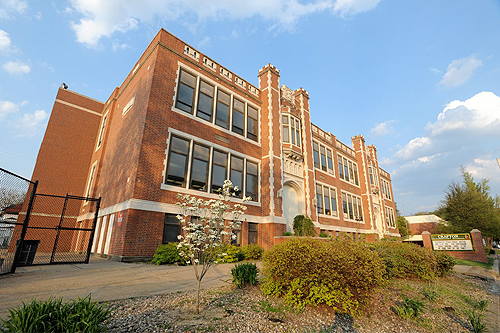
Crafton Councilwoman April Weitzel called the building a “gem of the community that has served and will continue to serve the citizens of Crafton and Carnegie.” Councilwoman Weitzel is convinced that renovating the school will be less expensive, resulting in no tax increases for the district. She further stated that “maintaining our neighborhood schools instead of abandoning them helps stabilize property values and encourages others to move into Carnegie and Crafton.”
Pittsburgh History & Landmarks Foundation would like to see this building continue being used as a school and has expressed its concern about possible closure of this important community asset. Renovation of historic schools is often less expensive than new construction. Restoration supports “green” policy and helps stabilize historic neighborhoods. This issue is scheduled to be discussed at the next School Board meeting. Comments can be sent to:
Carlynton School District
435 Kings Highway
Carnegie PA 15106
Click for MapBoard Meeting: Thursday, February 3, 2011 at 7:00 p.m. in the High School Cafeteria
and
Board Meeting: Thursday, February 17, 2011 at 7:30 p.m. in the High School Cafeteria -
The New Granada Theater Listed on National Register of Historic Places
The New Granada Theater, which housed a prominent Hill District civic organization, and was also used as a movie theater, live entertainment venue, and community center for decades, has been listed on the National Register of Historic Places. The listing, announced January 7, is the result of a submission of the Pittsburgh History & Landmarks Foundation (PHLF) and the Hill Community Development Corporation (Hill CDC).
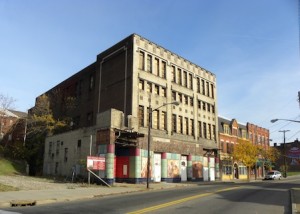 Designed in 1927 by Louis A.S. Bellinger, Pittsburgh’s first African American architect, the three-story building located at 2009-11 Centre Avenue was the Knights of Pythias Temple—an African American fraternal organization—from its opening in 1928 to 1936. It re-opened as the New Granada Theater in May 1937, under the management of the Handel Theater Corporation and remained active until the 1970s when it closed under private ownership. After years of vacancy and deterioration, the Hill CDC purchased the building in June 1995, with the help of a loan from PHLF.
Designed in 1927 by Louis A.S. Bellinger, Pittsburgh’s first African American architect, the three-story building located at 2009-11 Centre Avenue was the Knights of Pythias Temple—an African American fraternal organization—from its opening in 1928 to 1936. It re-opened as the New Granada Theater in May 1937, under the management of the Handel Theater Corporation and remained active until the 1970s when it closed under private ownership. After years of vacancy and deterioration, the Hill CDC purchased the building in June 1995, with the help of a loan from PHLF.The Hill CDC and PHLF collaborated on a $1.1 million stabilization of the New Granada in 2007-10, funded by The Heinz Endowments, the Commonwealth of Pennsylvania’s Redevelopment Capital Assistance Program, and Allegheny County’s Community Infrastructure and Tourism Fund.
African American architect, Milton Ogot, and Repal Construction Company assisted with the stabilization project.
“The renewal of this building will anchor future development in the entire area. We look forward to the results of the visioning process now underway by the Hill CDC,” said PHLF President Arthur Ziegler.
The New Granada is one of 32 sites in Pittsburgh’s Hill District featured in PHLF’s forthcoming book, August Wilson: Pittsburgh Places in His Life and Plays, by Laurence A. Glasco and Christopher Rawson, with introductions by Kimberly C. Ellis and Sala Udin. A book signing and celebration, free to the public, will be on Saturday, February 26, 1-3pm, Ebenezer Baptist Church, 2001 Wylie Avenue, Pittsburgh, PA 15219. Reservations required: marylu@phlf.org; 412-471-5808 ext. 527.
-
Historic Swissvale Church Receives Second Life as Condominium Development
John Farley, Pop City Media
Wednesday, January 26, 2011
The Madonna del Castello Church at 7416 Duquesne Avenue in Swissvale has sat vacant for five years since its congregation left, leaving the unique brick building to fall into considerable disrepair. The church will experience new life as (a) condominium complex thanks to a partnership between the community, The Mon Valley Initiative, and the Swissvale Economic Development Corporation, who have begun construction that will incorporate many of the church’s original architectural features into the redesign.
“Its reuse as a church wasn’t going to be feasible so we looked at other options to maintain this part of the neighborhood,” says Patrick Shattuck, senior real estate developer for The Mon Valley Initiative, who purchased the property last September for $10,000.
Working with plans by Lami Grubb Architects, Mistick Construction is currently installing structural steel supports and expects the project to be completed by late spring or early summer. The plaster moldings and original arches will stay, becoming part of the new townhouse-style condos.
Three of the four condos will be 1,600-square-foot, two-bedroom, one-and-a-half-bathroom units. The fourth condo will be a 2,400-square-foot, three-bedroom, two-and-a-half-bathroom unit, which will feature the large dome that is currently over the altar as part of the space. The condos will range in price between $80,000 to $105,000.
A former rectory and convent next door to the church had to be demolished but the vacant lot where they once stood will soon be put to good use. “We had hoped to renovate the buildings, but ultimately they proved to be too far gone. It is a buildable lot, so whether we include that in the future phase for a house or whether we leave it for public green space will be determined,” says Shattuck.
Writer: John Farley
Source: Patrick Shattuck, The Mon Valley InitiativeImage courtesy of The Mon Valley Initiative
-
Tax Incentives for Historic Buildings
Federal Preservation Tax Incentives for Historic Buildings
The Federal Preservation Tax Incentives Program encourages the reuse and rehabilitation of historic buildings through two tax benefits: federal rehabilitation tax credits and charitable contribution deductions for the donation of preservation easements. Both incentives are available for historic buildings or buildings within districts that are listed on the National Register of Historic Places (National Register) and/or are contributing structures to “registered historic districts,” which includes National Register-listed historic districts and state or local historic districts that are certified by the U.S. Secretary of the Interior (Secretary). The programs are administered by the Pennsylvania Historical and Museum Commission (PHMC) on behalf of the National Parks Service and the U.S. Secretary of the Interior.
Rehabilitation Tax Credits
Two levels of rehabilitation tax credits are available: a 20% rehabilitation tax credit for projects that the Secretary designates as certified rehabilitation of a historic structure and a 10% rehabilitation tax credit for the rehabilitation of non-historic buildings placed in service before 1936. The 20% rehabilitation tax credit is more frequently used in the Pittsburgh region. It was instrumental in the financing of the Heinz Lofts, the Armstrong Cork Factory, the Bedford Springs Resort, and Market at Fifth––a project of the Pittsburgh History & Landmarks Foundation.
To access the 20% rehabilitation tax credit, owners and developers must fully comply with the Internal Revenue Service’s requirements. The process is overseen and managed by PHMC and includes, among other things, a three-part application that: (i) certifies that the building is a certified historic structure; (ii) approves the plans and specifications for the rehabilitation work, and (iii) certifies that the rehabilitation was completed in accordance with the plans after the work is complete. The 20% rehabilitation tax credit requires that:
- the building is a certified historic structure (as discussed above);
- the building is depreciable, i.e. income producing such as offices or rental housings;
- the rehabilitation is substantial; and
- the property must be placed in service or put into use after the rehabilitation, among other things.
More information on rehabilitation tax credits can be found at the PHMC and NPS Web sites.
Preservation Easements
Section 170(h) provides a charitable contribution deduction for a donation of a preservation easement on certified historic structures to a qualified organization such as PHLF. In exchange, the donor of a preservation easement receives a federal charitable contribution deduction equal to the fair market value of the preservation easement as determined by a “qualified appraisal” conducted by a “qualified appraiser.”
A preservation easement is a legal agreement negotiated between the donor/property owner and PHLF that places restrictions on the exterior, and sometimes the interior, of a historic property so that it will be preserved forever or in perpetuity. The owner retains the right to make changes to the property in accordance with the Secretary’s Standards for Rehabilitation. The preservation easement is recorded in the local recorder of deeds office and runs with the land. PHLF is then responsible for monitoring the property on an annual basis to ensure compliance.
PHLF has received over 30 preservation easements on buildings in Allegheny, Bedford, Butler, Greene, Washington, and Westmoreland Counties. These include single-family homes, large industrial complexes that have been rehabilitated into apartments, downtown condominium buildings, historic farms and farmland, and a historic resort hotel. More information on preservation easements and PHLF’s preservation easement program can be found at the following Web sites: PHMC, NPS and PHLF.
NOTE: PHLF does not provide tax or legal advice. The above information is for informational purposes only and does not include all of the details and requirements of the Federal Preservation Tax Incentive Programs or the Internal Revenue Code. Please consult your own attorney and tax advisor if you are interested in these programs.
-
The Making of a Mural: Series of Coincidences Led to Collaboration Between Artist and North Side Homeowner
Saturday, January 15, 2011
By Kevin Kirkland, Pittsburgh Post-Gazette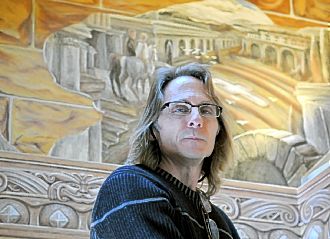
Artist Ken Heusey in front of the mural he created for David McAnallen's renovated kitchen on the North Side. Pam Panchak / Post-Gazette
Life is sometimes like a movie script. Or maybe it just seems that way to Ken Heusey because he worked in Hollywood for 16 years.
Only in a movie would absentmindedly leaving your cell phone on a table in an airport restaurant lead to painting murals in a South Side restaurant and a restored North Side townhouse. The work has been a triumph and a treat for Mr. Heusey, an accomplished photographer and native of Fombell, Beaver County, who did fashion shoots and lighting on movie sets, including making Matt Damon look good in “Oceans 12.”
David McAnallen, who is finishing a nine-year renovation of an 1860s brick townhouse in the North Side’s Manchester neighborhood, is glad fate brought them together. No one else could have imagined and created the classical mural that draws your eyes up the moment you step into his kitchen.
“The collaboration with Ken was wonderful. As you walk around, you’re captivated. It sucks you in,” said Mr. McAnallen, a psychologist.
Mr. Heusey, 46, was heading back to Los Angeles a year-and-a-half ago when he stopped to eat at the T.G.I. Friday’s at the Pittsburgh International Airport and left his cell phone. Upon his return, he stopped in and asked to see the manager who was holding it for him. The server he spoke with recognized him — She was his 10th-grade date for the homecoming dance at Riverside High School.
That connection led to an introduction to the owners of Hofbrauhaus Pittsburgh on the South Side. Last fall, Mr. Heusey painted a large two-section mural of 19th-century barmaids and beer drinkers on the terrace overlooking the beer garden. He was finishing that project when he met Mr. McAnallen while the two men were working out at the North Side YMCA. When Mr. McAnallen saw his photos of the Hofbrauhaus project, he decided he’d found the artist to decorate his newly renovated kitchen.
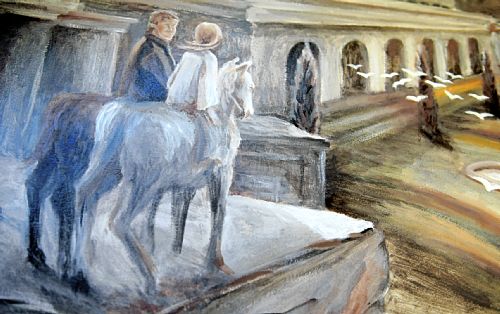
A detail from the mural Ken Heusey painted for David McAnallen's renovated kitchen. Pam Panchak / Post-Gazette
“I had thought about a mural before, but it never happened,” he recalled. “The space is so angular. I wanted to soften the angles.”
The space is an alcove around a new Velux skylight Mr. McAnallen added to the kitchen. Although Mr. Heusey had in mind a prominent spot visible from the doorway, it ended up closer to the ceiling, revealing itself gradually as a visitor enters the kitchen. The homeowner wanted something subtle.
“It was too big, too bold there,” Mr. Heusey agreed.
The artist suggested a trompe l’oeil painting in which old sandstone walls and a fragment of an old mural peek out from beneath layers of plaster. His inspiration for the classical scene came from a Gustave Dore engraving, “Isaiah’s Vision of the Destruction of Babylon.” He liked the mood of the drawing, especially the stormy sky. Mr. McAnallen liked it, too, but he asked the artist to take out the debris. He also added a pond similar to the one the homeowner had installed in his side yard. Isaiah was replaced with one horseman, then two.
“I like to create a story,” Mr. Heusey said, adding that he leaves the story’s details to the viewers’ imagination.
He copied the pattern of the faux stone corbeling beneath the scene from a nearby building and the carved lion’s face from an oak chair that is a McAnallen family heirloom.
Mr. Heusey spent about three weeks working on the painting, interrupted by the holidays. Before he started, he warned Mr. McAnallen that he would probably have concerns in the middle of the project, when he was still roughing in the design. He was right:
“I panicked only one time,” Mr. McAnallen admitted. “A lot of orange was coming through. I thought ‘Did I do the right thing?'”

David McAnallen at his home on Sheffield Street in Manchester on the North Side. Pam Panchak / Post-Gazette
The artist explained that the orange was underpainting and that it would not look that way in the final painting. And it doesn’t.
The two men declined to say what the project cost. Mr. Heusey, who spends about half of his time painting murals and the other half doing commercial photography, said his price depends upon the size, detail and complexity of the project. He says collaboration between artist and client yields a painting that pleases both.
“We let it evolve,” he said. “By going back and forth, we created something better.”
To contact Ken Heusey, call 310-963-6772 or go to www.khprod.com, which includes photos taken as he worked on the McAnallen project.
-
Denis Theatre Foundation Names Executive Director
Thursday, January 13, 2011
Pittsburgh Post-GazetteThe Denis Theatre Foundation on Wednesday named Valerie Golik, the former executive director of The Pittsburgh Philharmonic, as its new executive director.
She replaces board member Jennifer Smokelin, who has served as interim director since the fall.
“We are delighted that Valerie is joining the Denis Theatre Foundation,” Ms. Smokelin said in a news release. “She brings with her an excellent background in arts management, programming, and a strong track record in fundraising and planning.”
When Ms. Golik, of Marshall, assumes the role Jan. 17, she will direct the foundation’s goal of restoring and re-opening the Denis Theatre on Washington Road in Mt. Lebanon. The theater, which opened in 1938, closed in 2004 in a state of disrepair. The nonprofit Denis Theatre Foundation formed in 2007 and began a fundraising campaign, with the goal of purchasing the building and restoring it as an independent film theater and community cultural center.
In September, the foundation announced it had raised enough money to purchase the building. Ms. Golik will assist with the capital campaign to raise $2.5 million to open the first of three planned screens. So far, the foundation has raised $900,000.
The foundation hopes to open the first screen in mid-2012.
“We are counting on broad support from individuals, businesses and charitable foundations from throughout the Pittsburgh area,” Ms. Golik said. “Once re-opened, the Denis will be a true regional asset.”
-
Friendship May Get Aldi Grocery
Tuesday, January 11, 2011By Mark Belko, Pittsburgh Post-GazetteDiscount grocer Aldi appears to be headed to the East End as part of the redevelopment of a former car dealership.
Michigan-based Warner Pacific Properties is expected to brief the city planning commission today about its plans to convert the Day Automotive dealership into a grocery, offices and other retail uses.
The grocer in question is believed to be Aldi, although Leslie Peters, an attorney for Warner Pacific, said the developer did not yet have an agreement with any particular store.
Asked if Warner Pacific were talking to Aldi, Ms. Peters replied, “I think you can infer that.” City Councilman William Peduto, who represents the area, said Warner Pacific had stated that Aldi would be the grocer.
The developer is proposing an 18,000-square-foot grocery at the site at Baum Boulevard and Roup Street in Friendship. It is also planning 44,000 square feet of office space and 3,000 square feet of retail space.
Ms. Peters said Warner Pacific planned to keep the exterior intact.
The building, with a corner tower that once displayed pulsating light after dark, has some historic value. Built in the early 1930s as a Chrysler sales and service building, it remained as an auto dealership until it was closed in 2009 by the Day Automotive Group.
“We’ll be reusing the existing building,” Ms. Peters said. “We believe it’s a significant structure, at least for Pittsburghers. Everybody knows the building.”
She added that the developer did plan some interior renovations to upgrade the space. The total project cost is estimated at $4 million.
Because the property is a former auto dealership, Mr. Peduto said there are ramps within it that will allow for parking on the upper floors. The grocery will be on the first floor. He said an adjacent structure would be converted for office use.
Mr. Peduto said the project has the support of the Baum-Centre Initiative group. Through a community process, the developer is also addressing concerns about traffic patterns and other issues, he said.
After a planning commission briefing today, Warner Pacific is expected to appear before the city’s Zoning Board of Adjustment Thursday to request a special exception that would allow the property to be used for a grocery and office space.
Ms. Peters said the developer hoped to get all permits needed for the project by February or March and then start construction.
-
Saxonburg Gets $1.4 Million for Main Street
By Tom Fontaine
PITTSBURGH TRIBUNE-REVIEW
Friday, January 7, 2011Saxonburg has received a $1.4 million state grant to make long-awaited improvements along historic Main Street without robbing any of its 19th century charm.
“We’re going to take new materials and create an atmosphere like it was in the 1850s and ’60s,” said Ray Rush, who will oversee the project for the tiny Butler County borough.
Saxonburg’s grant was the largest of six totaling more than $4.4 million announced Thursday by PennDOT. The agency awarded almost $25 million statewide through its Pennsylvania Community Transportation Initiative. The program provided $59.2 million for transportation projects in 2009.
Saxonburg will use its money to install new curbs, brick sidewalks, planter strips with trees, and period lighting along 1,100 feet of Main Street. That will cover roughly half of the area that is recognized as a historic district both nationally and by the state.
The borough can trace its roots to engineer John Roebling, famed for his designs of wire cable and suspension bridges. He designed and developed Saxonburg almost four decades before he began designing the Brooklyn Bridge in the late 1860s.
“It’s important to celebrate the old. It’s something all communities should be concerned about,” Rush said. The work will begin next fall and should be completed in 2012.
The city of Pittsburgh will receive $280,000 for a traffic study in the Strip District and Lawrenceville related to its Allegheny Riverfront Green Boulevard development project. The city wants to help make its largely industrial Allegheny riverfront home to lush green spaces, trails, housing, commercial development and commuter rail.
“This most recent grant will allow us to continue the positive momentum that is happening in these vibrant neighborhoods,” said Mayor Luke Ravenstahl.
Other grant recipients include:
• Richland, $1.3 million, to improve pedestrian access and traffic flow near the intersection of Route 8 and Ewalt Road.
• Airport Corridor Transportation Association, $700,000, to reduce congestion and provide better transit, pedestrian and bicycle access in the Robinson and North Fayette commercial area.
• Washington County, $443,500, to develop 9 miles of recreational trail to complete the Panhandle Trail between Carnegie and Weirton, W.Va.
• Armstrong County, $300,000, to perform a traffic study in Kittanning.

